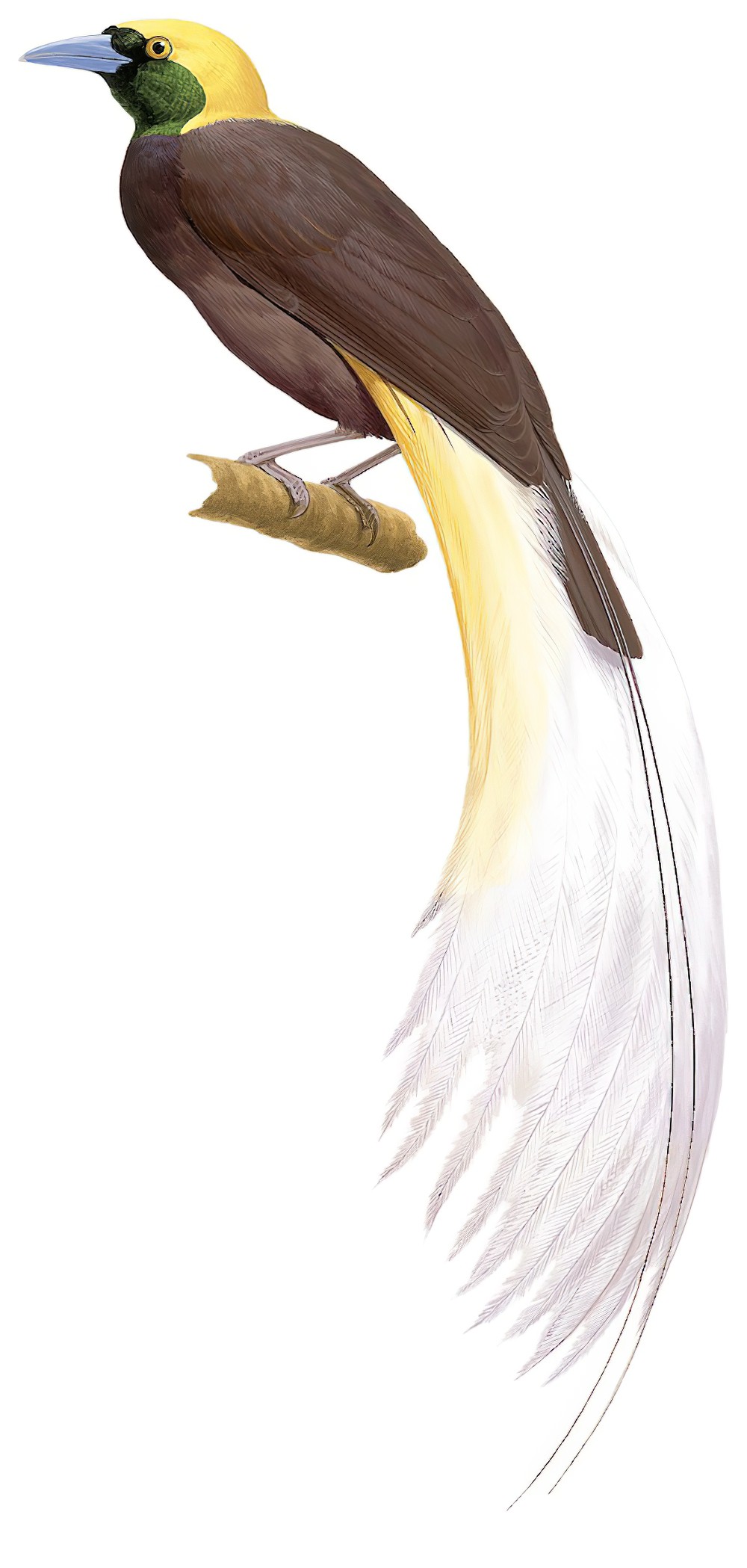Greater Bird-of-Paradise / Paradisaea apoda

Greater Bird-of-Paradise
SCI Name:
Protonym: Paradisaea apoda Syst.Nat.ed.10 p.110
Taxonomy: Passeriformes / Paradisaeidae / Paradisaea
Taxonomy Code: gbopar2
Type Locality: India [= Aru Islands].
Author: Linnaeus
Publish Year: 1758
IUCN Status: Least Concern
DEFINITIONS
PARADISAEA
(Paradisaeidae; Ϯ Greater Bird-of-Paradise P. apoda) Late L. paradisus paradise < Gr. παραδεισος paradeisos paradise, pleasure ground (of the Persian kings) < Old Persian pairi-daēza walled garden; Magellan’s sailors were told by Moluccan natives that the exotic birds-of-paradise came from heaven, being called ‘birds of god’ (see apoda); "51. PARADISÆA. Rostrum basi plumis tomentosis tectum. Pennæ hypochondriorum longiores." (Linnaeus 1758); "Paradisaea Linnaeus, 1758, Syst. Nat., ed. 10, 1, p. 110. Type, by subsequent designation (Gray, 1840, p. 39), P. apoda Linnaeus." (Mayr in Peters 1962, XV, 199). Linnaeus's Paradisaea comprised two species (P. apoda, P. regia) (Cracraft 1992, recognised fourteen phylogenetic species herein).
Var. Paradisea, Paradisia.
Synon. Manucodiata, Samalia, Trichoparadisea, Uranornis.
paradisaea / paradisaeus
Med. L. paradiseus of paradise, paradisean, ethereal < Late L. paradisus paradise.
apoda
Gr. negative prefix α- a-; πους pous, ποδος podos foot; “That Birds of Paradise want feet is not only a popular persuasion, but a thing not long since believed by learned men and great Naturalists ... deceived by the birds dried or their cases, brought over into Europe out of the East Indies, dismembred, and bereaved of their Feet ... These most beautiful birds ... are called by the inhabitants of the Molucca Islands Manucodiatae, that is, Gods birds, and had in great esteem and veneration. They are called Birds of Paradise, both for the excellent shape and beauty of their bodies, and also because where they are bred, whence they come, and whither they betake themselves is altogether unknown, sith they are found only dead upon the earth, so that the Vulgar imagine them to drop out of Heaven or Paradise” (Ray 1678); "51. PARADISÆA. ... apoda. 1. P. pennis hypochondriis corpore longioribus, rectricibus intermediiis longis setaceis. Paradisea lutea, cauda pectore abdomineque brunneis, gula azurea. It. Wgoth. 139. Mus. Ad. Fr. I. p. 15. Paradisea avis. Clus. exot. 360. t. 360. Olear. mus. 24. t. 13. f. 1. Seb. mus. I. p. 24. t. 13. f. 1. Hern. mex. 317. t. 318. Worm. mus. 294. f. 294. Bradl. nat. t. 12. f. 1. 2. Manucodiata major. Edw. av. 110. t. 110. Marcgr. bras. 201. Raj. av. 21. n. 7. Habitat in India; gregaria. Cirrhi 2 caudæ apice attenuati, nudi, recti. Apodam perperam dixere veteres; victitat Papilionibus maximis." (Linnaeus 1758) (Paradisaea).
SUBSPECIES
Greater Bird-of-Paradise (apoda)
SCI Name: Paradisaea apoda apoda
apoda
Gr. negative prefix α- a-; πους pous, ποδος podos foot; “That Birds of Paradise want feet is not only a popular persuasion, but a thing not long since believed by learned men and great Naturalists ... deceived by the birds dried or their cases, brought over into Europe out of the East Indies, dismembred, and bereaved of their Feet ... These most beautiful birds ... are called by the inhabitants of the Molucca Islands Manucodiatae, that is, Gods birds, and had in great esteem and veneration. They are called Birds of Paradise, both for the excellent shape and beauty of their bodies, and also because where they are bred, whence they come, and whither they betake themselves is altogether unknown, sith they are found only dead upon the earth, so that the Vulgar imagine them to drop out of Heaven or Paradise” (Ray 1678); "51. PARADISÆA. ... apoda. 1. P. pennis hypochondriis corpore longioribus, rectricibus intermediiis longis setaceis. Paradisea lutea, cauda pectore abdomineque brunneis, gula azurea. It. Wgoth. 139. Mus. Ad. Fr. I. p. 15. Paradisea avis. Clus. exot. 360. t. 360. Olear. mus. 24. t. 13. f. 1. Seb. mus. I. p. 24. t. 13. f. 1. Hern. mex. 317. t. 318. Worm. mus. 294. f. 294. Bradl. nat. t. 12. f. 1. 2. Manucodiata major. Edw. av. 110. t. 110. Marcgr. bras. 201. Raj. av. 21. n. 7. Habitat in India; gregaria. Cirrhi 2 caudæ apice attenuati, nudi, recti. Apodam perperam dixere veteres; victitat Papilionibus maximis." (Linnaeus 1758) (Paradisaea).
Greater Bird-of-Paradise (novaeguineae)
SCI Name: Paradisaea apoda novaeguineae
novaeguinae / novaeguineae / novaeguineensis
L. novus new; Mod. L. Guineensis Guinean < Guinea Guinea, West Africa; i.e. New Guinea (first named Nueva Guinea in 1545 by the Spanish explorer Ortíz de Retes, because aborigines in the Mamberano region reminded him of those he had encountered earlier in African Guinea).
● ex “Lori noir de la Nouvelle Guinée” of Sonnerat 1776, and “Black Lory” of Latham 1781 (syn. Chalcopsitta atra).
● ex “Choucas de la Nouvelle Guinée” of d’Aubenton 1765-1781, pl. 269, and “New-Guinea Crow” of Latham 1781 (syn. Coracina striata).
● Erroneous TL. New Guinea (= New South Wales); ex “Grand Martin-pêcheur de la Nouvelle Guinée” of Sonnerat 1766, “who had received the specimen from Cook’s botanist, Joseph Banks, at Cape Town. Sonnerat had never travelled to either New Guinea or Australia” (Robin 2001) (Dacelo).
● ex “Crabier de la Nouvelle Guinée” of d’Aubenton 1765-1781, pl. 926, “Crabier noir” of de Buffon 1770-1786, and “New Guinea Heron” of Latham 1785 (syn. Egretta sacra).
● ex “Caille de la nouvelle Guinée” of Sonnerat 1776, and “New Guinea Quail” of Latham 1783 (unident.).
UPPERCASE: current genus
Uppercase first letter: generic synonym
● and ● See: generic homonyms
lowercase: species and subspecies
●: early names, variants, mispellings
‡: extinct
†: type species
Gr.: ancient Greek
L.: Latin
<: derived from
syn: synonym of
/: separates historical and modern geographic names
ex: based on
TL: type locality
OD: original diagnosis (genus) or original description (species)












